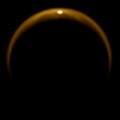Berkas:PIA12481 Titan specular reflection.jpg

Ukuran pratayang ini: 600 × 600 piksel. Resolusi lainnya: 240 × 240 piksel | 480 × 480 piksel | 768 × 768 piksel.
Ukuran asli (768 × 768 piksel, ukuran berkas: 35 KB, tipe MIME: image/jpeg)
Riwayat berkas
Klik pada tanggal/waktu untuk melihat berkas ini pada saat tersebut.
| Tanggal/Waktu | Miniatur | Dimensi | Pengguna | Komentar | |
|---|---|---|---|---|---|
| terkini | 12 Desember 2018 15.29 |  | 768 × 768 (35 KB) | Kesäperuna | 100% JPEG quality from full quality TIFF. |
| 18 Desember 2009 07.16 |  | 768 × 768 (14 KB) | WolfmanSF | {{Information |Description={{en|1=This image shows the first flash of sunlight reflected off a lake on Saturn's moon Titan. The glint off a mirror-like surface is known as a specular reflection. This kind of glint was detected by the visual and infrared m |
Penggunaan berkas
Halaman berikut menggunakan berkas ini:
Penggunaan berkas global
Wiki lain berikut menggunakan berkas ini:
- Penggunaan pada an.wikipedia.org
- Penggunaan pada ar.wikipedia.org
- Penggunaan pada be.wikipedia.org
- Penggunaan pada ca.wikipedia.org
- Penggunaan pada cs.wikipedia.org
- Penggunaan pada en.wikipedia.org
- Penggunaan pada en.wikinews.org
- Penggunaan pada en.wikiversity.org
- Solar System, technical/Titan
- Draft:Original research/Titan
- Astronomy college course/Miranda and Titan
- Astronomy college course/Miranda and Titan/questions
- OpenStax Astronomy/Test 3 Study guide
- Astronomy college course/Unit 3 study guide
- Wright State University Lake Campus/2016-1/Phy1060/T3 upgrade
- Wright State University Lake Campus/2017-1/Phy1060/printPDF
- Wright State University Lake Campus/2019-1/Phy1060/Old studyguide/Pdf
- Quizbank/All questions
- Penggunaan pada fr.wikipedia.org
- Penggunaan pada gl.wikipedia.org
- Penggunaan pada hy.wikipedia.org
- Penggunaan pada it.wikipedia.org
- Penggunaan pada ja.wikipedia.org
- Penggunaan pada ka.wikipedia.org
- Penggunaan pada mk.wikipedia.org
- Penggunaan pada mwl.wikipedia.org
- Penggunaan pada no.wikipedia.org
- Penggunaan pada pl.wikipedia.org
- Penggunaan pada pt.wikipedia.org
- Penggunaan pada ro.wikipedia.org
- Penggunaan pada ru.wikipedia.org
- Penggunaan pada ta.wikipedia.org
- Penggunaan pada ta.wikinews.org
- Penggunaan pada uk.wikipedia.org
- Penggunaan pada vi.wikipedia.org
- Penggunaan pada xmf.wikipedia.org
Lihat lebih banyak penggunaan global dari berkas ini.


